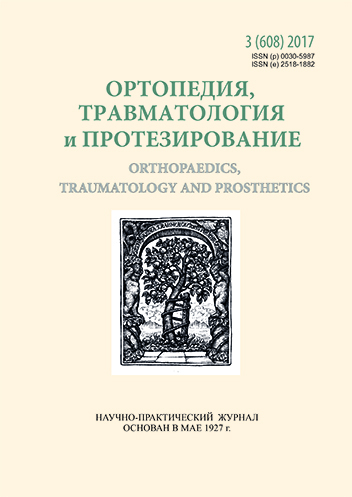Long-term results of bipolar hemarthroscopic treatment of elderly and senile women with multiple fragment fractures of the proximal femur
DOI:
https://doi.org/10.15674/0030-59872017385-90Keywords:
fragmentation fractures, proximal femur, elderly and senile subjects, hemiarthroplasty, long-term results of treatmentAbstract
Treatment of elderly and senile patients with fractures of the proximal femur remains an relevant problem in clinical medicine. Joint replacement in such patients is an alternative to osteosynthesis.
Objective: to study the long-term results of treatment of elderly and senile patients with fragment fractures proximal femur by the method of bipolar hemiarthroplasty.
Methods: the results of treatment of 20 patients (mean age (79.2 ± 9.1) years) with proximal femur fractures evaluated by cement bipolar hemiarthroplasty with augmentation and fixation with wires were evaluated. In 60 % of the patients there were fractures of type 31A2 according to AO/ASIF classification, in 25 % — 31A3. All have a concomitant pathology with the prevalence cardiovascular system deseases. The pain syndrome, the static-dynamic activity of the patients, the deformation and the amplitude of the movements of the operated limb were evaluated using the Harris score.
Results: excellent and good results were obtained in 95 % of patients, unsatisfactory — in 5 %. The evaluation o f t he f unctional s tate a ccording t o the Harris s core i ncreased from (64.9 ± 13.4) scores on the 12th day to (86.3 ± 6.9) and (89.5 ± 4.8) scores at 2 months and 3–5 years respectively.
Conclusions: the results of treatment of elderly and senile patients with fragment fractures of proximal femur using the method of bipolar hemiarthroplasty testify to its effectiveness. The use of this method allows to improve the quality of life in patients after surgery due to the early function of the hip joint and the damaged lower limb. Preservation of bone fragments and their wire fixation during joint replacement of lateral fractures of the femur provides stability of the implant, helps minimize its «subsidence» in the femoral canal.References
- Azizov MZh, Alibekov MM, Valiev EYu. On the treatment of trochanteric fractures of the femur. N. N. Priorov Bulletin of Traumatology and Orthopedics. 2000;3:56-9. (in Russian)
- Korzh NA, Dedukh NV. Risk factors for osteoporosis. International Medical Journal. 2007;2:70-4. (in Russian)
- Nesledov A. SPSS 19: professional statistical analysis of data. St. Petersburg: Piter, 2011. 400 p. (in Russian)
- Golubev VG, Starostenkov AN, Vorontsov AP, et al. Experience in the treatment of elderly patients with fractures of the proximal femur in the Central Research Library of the Russian Academy of Sciences: abstracts of the all-Russian scientific-practical conference with international participation: “Problems of diagnosis and treatment of injuries and diseases of the hip joint”. Kazan, 2013, pp. 27-35. (in Russian)
- Dulaev AK, Tsed AN, Dzhusoev IG, Usubaliev KN. Osteosynthesis of femoral neck fractures: dynamic hip screw (DHS) or mini-invasive Targon FN system. Traumatology and Orthopedics in Russia. 2015;3:12-22. doi: 10.21823/2311-2905-2015-0-3-12-21. (in Russian)
- Kornilov NV, Gryaznukhin EG. Traumatology and orthopedics: in 4 vol.: Injuries and diseases of the lower extremities. St. Petersburg: Hippocrates, 2006;3:1053. (in Russian)
- Shaposhnikov YuG. Traumatology and orthopedics. M.: Medicine, 1997;2:592 p. (in Russian)
- Bottai V, Giannotti S, Dell'osso G, De Paola G, Menconi A, Falossi F, Raffaetà G, Guido G. Atypical femoral fractures: retrospective radiological study of 319 femoral fractures and presentation of clinical cases. Osteoporosis Int. 2014;25(3):993-7. doi: 10.1007/s00198-013-2546-8.
- Bonnaire F, Lein T, Bula P. Trochanteric femoral fractures: anatomy, biomechanics and choice of implants. Unfallchirurg. 2011;114(6):491-500. doi: 10.1007/s00113-011-1973-2.
- Bao NR, Zhao JN, Zhou LW, Zeng XF, Guo T. Complications of bipolar hemiarthroplasty for the treatment of unstable intertrochanteric fractures in the elderly. Zhongguo Gu Shang. 2010;23(5):329-31.
- Harris WH. Traumatic arthritis of the hip after dislocation and acetabular fractures: treatment of mold arthroplasty. J Bone Joint Surg. 1969;54-A:61-76.
- Little EA, Eccles MP. A systematic review of the effective ness of interventions to improvepost-fracture in vestigation and management of patients at risk of osteoporosis. Implementation Science. 2010;5:80. doi: 10.1186/1748-5908-5-80.
- Mazen S, Julien G, Hassan K. The effective ness of primary bipolar arthroplasty in treatment of unstable intertrochanteric fractures in elderly patients. N Am J Med Sci. 2010;2(12):561-8. doi: 10.4297/ najms.2010.2561.
- Thakkar C, Kathalgere R, Kumar M. Calcar femoral grafting in the hemiarthroplasty of the hip for unstable intertrochanteric fractures. Indian J Orthop. 2015;49(6):602-9. doi: 10.4103/0019-5413.168762.
Downloads
How to Cite
Issue
Section
License
Copyright (c) 2017 Andrii Kalchenko

This work is licensed under a Creative Commons Attribution 4.0 International License.
The authors retain the right of authorship of their manuscript and pass the journal the right of the first publication of this article, which automatically become available from the date of publication under the terms of Creative Commons Attribution License, which allows others to freely distribute the published manuscript with mandatory linking to authors of the original research and the first publication of this one in this journal.
Authors have the right to enter into a separate supplemental agreement on the additional non-exclusive distribution of manuscript in the form in which it was published by the journal (i.e. to put work in electronic storage of an institution or publish as a part of the book) while maintaining the reference to the first publication of the manuscript in this journal.
The editorial policy of the journal allows authors and encourages manuscript accommodation online (i.e. in storage of an institution or on the personal websites) as before submission of the manuscript to the editorial office, and during its editorial processing because it contributes to productive scientific discussion and positively affects the efficiency and dynamics of the published manuscript citation (see The Effect of Open Access).














